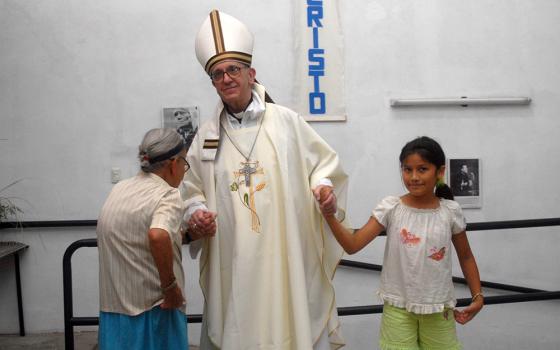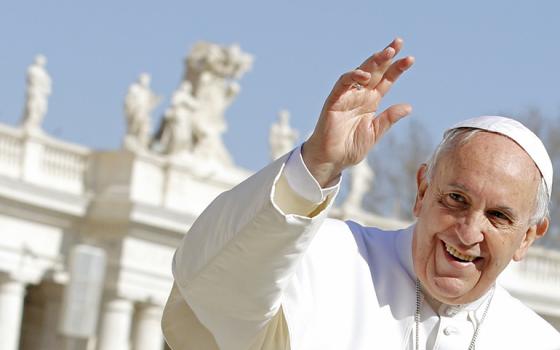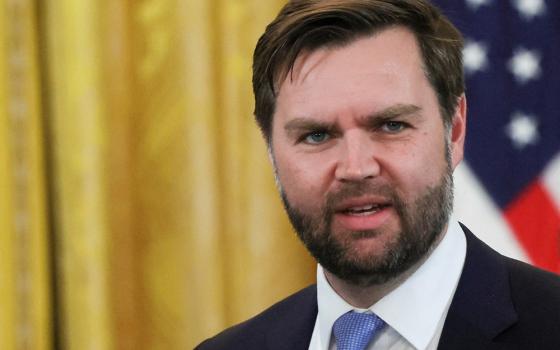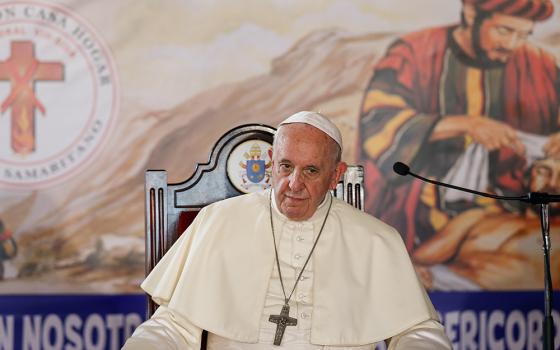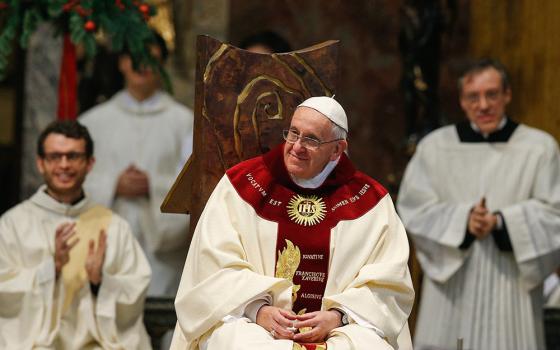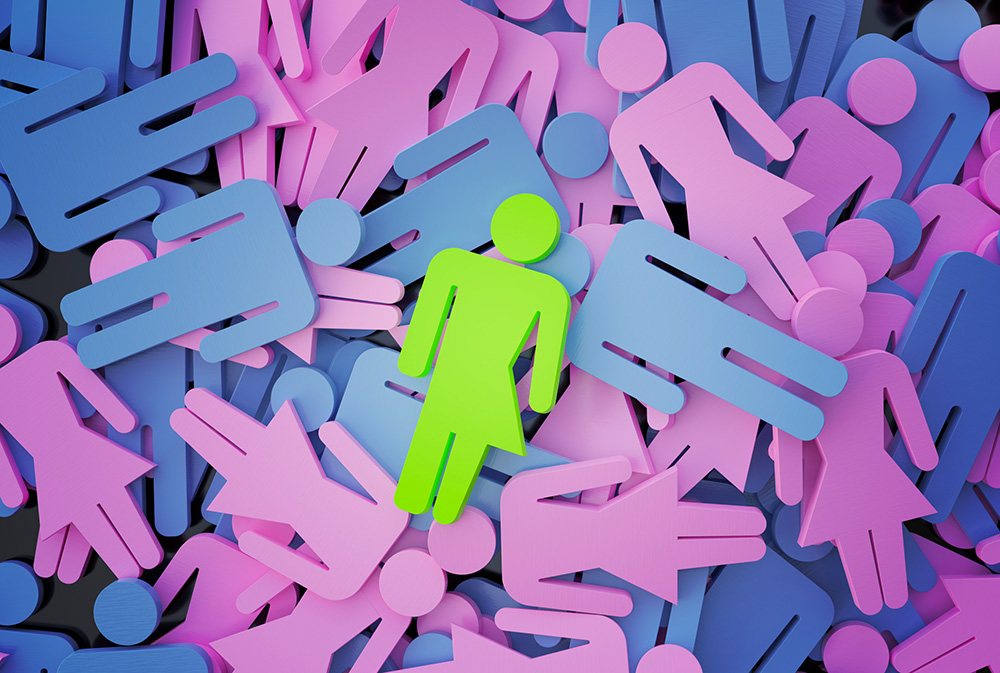
(Dreamstime/Vchalup)
When Pharisees complained that Jesus received sinners and ate with them, he responded with a parable. "What man of you, having a hundred sheep, if he has lost one of them, does not leave the ninety-nine in the wilderness and go after the one which is lost, until he finds it? And when he has found it, he lays it on his shoulders, rejoicing" (Luke 15:3-6).
We argue — contra former St. Louis Archbishop Robert Carlson's letter "Compassion and Challenge" and a February 2019 document from the Vatican Congregation for Catholic Education, "Male and Female He Created Them," both of which address "gender ideology" — that transgender and intersex persons are not sinners, but they are lost sheep in the Catholic wilderness.
The term transgender describes people who have been born with typical female or male anatomies but whose self-experience convinces them that their actual gender identity does not match their gender identity assigned at birth. Transgender is contrasted with cisgender, people whose gender identity matches their gender identity assigned at birth.
A UCLA study in 2016 revealed that there are about 1.4 million adults in the United States who identify as transgender, a small minority lost in the overpowering millions of cisgender people.
They are also lost in the wilderness of the Catholic Church, which continues to affirm only the female-male binary that it accepts as created by God and absolute and to which it attaches unchangeable gender.
Intersex people, those born with ambiguous genitalia, often struggle with similar questions about gender identity as transgender people do. Transgender and intersex people differ in their anatomical structures at birth, and most intersex people self-identify as either female or male, but they often suffer the same pain from family rejection, bullying, and discrimination in both society and church.
That discrimination is mostly based on the unquestioned acceptance of the female-male sexual binary and the abhorrence, even hatred, of any sexual or gender arrangement that challenges it. The harrowing outcome of that bullying and discrimination was reported in a 2019 study from the American Academy of Pediatrics: Thirty-five percent of transgender teens reported that they had attempted suicide in the past year — more than triple the number of cisgender teens.
Parents, families and churches can start reducing those statistics by learning the facts about transgender people. Perhaps they might even learn to listen to Jesus in his concluding statement in his parable of the good Samaritan: "Go and do likewise" (Luke 10:37), that is, go and show mercy.
The bodies of intersex people would not be ambiguous and troubling, we suggest, if society and church were to listen to their claim that they constitute a minority third sex.
The biological reality of intersex people can give insight into the complex reality of transgender people and provide direction for the church's moral response to both groups. A quick scan of medical literature reveals that about two in every 1,000 live human births (0.2%) is a child who is intersex.
Now, 0.2% is a small frequency, but it is almost double the frequency of the birth of Down syndrome children, who deservedly get attention and respect in our society. Surely intersex children, lost and crying out in the social and Catholic wilderness, deserve the same attention and respect as human beings created by and in the mysterious image of the mysterious God.
Their intersex bodies are troubling to their parents, their society and their church for only one reason: They are judged to be biologically sexually ambiguous when compared to the dominant female-male binary. They would not be ambiguous and troubling, we suggest, if society and church were to listen to their claim that they constitute a minority third sex.
The nation's capital, Washington, D.C., and 11 states, including Arkansas, Colorado and Minnesota, already acknowledge this by a notation on the driver's licenses of intersex individuals. We believe that the love and concern that intersex people deserve should extend to transgender people and those with a psychologically ambiguous gender.
On the eve of his retirement as archbishop of St. Louis in July 2020, Carlson issued a letter, "Compassion and Challenge," that deals specifically with women and men who are transgender and the attitudes Catholics should have toward them. Despite its focus on transgender people and their treatment, the letter has implications also for intersex people and their treatment.
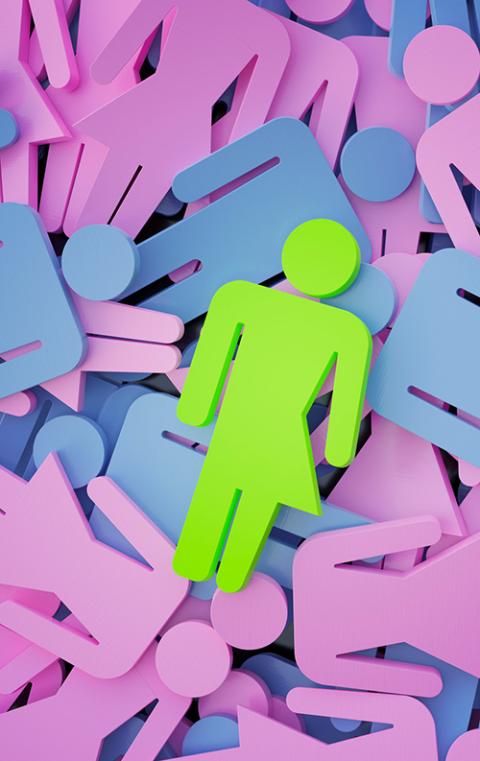
(Dreamstime/Vchalup)
The letter teaches that Catholics should be compassionate toward people who are transgender (and surely also toward people who are intersex), but that "there are limits to how we should manipulate our bodies." The instruction to be compassionate is a decidedly Catholic instruction, the but less so.
Carlson speaks of the feeling and desire to transition from one gender to another and argues, correctly, that feelings, of which we have a daily multitude, cannot be allowed to exclusively control our identity. There is, however, a distinction he misses between psychologically wanting to be in a different gender and physiologically needing to be in a different gender because the gender to which one has been assigned at birth is self-experienced as the wrong gender. That ongoing self-experience is a much stronger personal reality than a passing feeling or wanting, and it can be uncovered and verified by psychological analysis.
Despite Pope St. John Paul II's teaching that "the church values sociological and statistical research" (Familiaris Consortio, 5) and his lament that theologians do not utilize the data of science when exploring theological questions, Carlson asserts that the church forbids any medical intervention for transgender persons without recognizing the distinction between simply wanting and personally needing a gender transition.
He notes that the church does, however, "recognize that appropriate medical care is necessary in those rare cases of genetic or physical disorders of sexual development," that is, in those rare intersex cases. Yet one more example of the church's preference in its sexual ethics for a physical, anatomical foundation rather than a personal, human foundation.
Carlson was hewing to a line marked out by the Vatican document "Male and Female He Created Them." The subtitle of the document, "Towards a Path of Dialogue on the Issue of Gender Theory in Education," suggests that it might be interested in dialogue, but it is seriously lacking in listening to transgender and intersex people. "Intersex," indeed, is mentioned only in quotation marks, as if it were not a real population with real and painful experiences but only a population with a physiological aberration to be solved.
The problem to be solved is not a problem of "physiological aberration" in those born intersex or of illicit desire in those who transition their gender, but a problem of finding a framework beyond the accepted female-male binary to speak of all human persons and the meanings of their bodies.
There is also the problem of the mistake that both Vatican document and Carlson make, confusing and conflating unchangeable physical sex with changeable socially constructed gender. Again, dialogue between church authorities and contemporary social scientists would greatly clarify a murky problem.
The archbishop declares "male and female he created them" (Matthew 19:4; Genesis 1:27), interpreting this Scripture passage to imply that God created only two sexes, female and male. That interpretation, common among church authorities who are not biblical scholars, ignores the Vatican II-established Catholic rule for interpreting the meaning of the biblical words of God for our own time and culture (Dei Verbum, 12).
The problem to be solved is one of finding a framework beyond the accepted female-male binary to speak of all human persons and the meanings of their bodies.
What the sacred writer of Genesis actually expressed is "male and female he created them," not "only male and female he created them." Intersex as science understands it today was not recognized in the writer's time and culture, and so the writer could not possibly mention it, imply it or rule on it. To advance Genesis 1:27 as a proof that there are only two sexes established at birth and that gender is tied to those sexes is a serious misreading and misuse of the biblical word of God.
While some Christian churches affirm and welcome transgender and intersex persons, conservative Catholic and evangelical churches are still tempted to follow Victorian physicians who, to shore up the traditional female-male binary, sought to medically "correct" what they perceived as sexual ambiguity. We protest against and reject any medical procedure on transgender adults and intersex children more concerned with upholding conservative social and religious sexual norms than with respecting the dignity, integrity and agency of lost transgender and intersex persons.
Parents, medical personnel and church leaders must learn to allow transgender persons to make crucial decisions about their own bodies and to wait until intersex children are mature enough to make their own decisions about their own bodies, and refrain from any assumption that they are incapable of responsibly doing so. We protest against any surgical "correction" of an intersex child.
The biological "ambiguity" of intersex bodies, externally and internally, makes it difficult to assign a particular sex/gender to an intersex person through medical intervention, for contemporary science has recognized that gender and its expressions are determined not only biologically by chromosomes, hormones and genetics but also by nurturing and culture. Gender can be discerned by all persons, heterosexual, homosexual, transsexual and intersexual, only as they gain experience, knowledge and understanding of themselves and their bodies in the life they live.
Advertisement
The science surrounding gender challenges the naive claim in the Vatican document that doctors can determine the "constitutive identity" of an individual merely by identifying or rearranging her or his biological sex.
The mountain of testimony from intersex adults who were surgically "corrected" in infancy makes clear that, in their judgment, their "correction" impaired rather than enhanced their human flourishing. The similar testimony of transgender adults about psychological "correction" imposed on them is equally compelling.
The document "Male and Female He Created Them" has it right: Listening to the testimonies of both transgender and intersex populations is absolutely necessary if their human dignity is to be advanced and bullying and discrimination against them eradicated. Transgender and intersex persons, no less than every other person, are created in the mysterious image and likeness of the mysterious God. If created by God equal to every other human creature, we ask, why are they a threat to and lost in the Catholic Church?
Only because, we answer, of the church's unquestioned adherence to the statistically dominant female-male sex binary.
One famous sexually "corrected" person can serve as an example of all. Sally Gross was born intersex to Jewish parents in South Africa in 1953 and, although she was born with "ambiguous genitals," was assigned a male sex/gender and given the name Selwyn. Gross always knew she was different, and in puberty, when her sex drive never developed, she decided that she was just a natural celibate. That moved her to be baptized into the Catholic Church, which values celibacy. She joined the Dominican Order, was ordained a priest in 1987, and taught moral theology at the Dominican College at Oxford, England.
In the early 1990s, she returned to South Africa where she continued to teach and where, she told The Natal Witness newspaper in 2000, she finally had time to consider the tensions in her life. "There were two areas of tension: there was the issue of my Jewish/Christian identity and the issue of bodiliness and gender, although I thought that was secondary."
In South Africa, Gross found a competent counselor who helped her to recognize that she had been assigned the wrong sex/gender and should consider a sex/gender change.
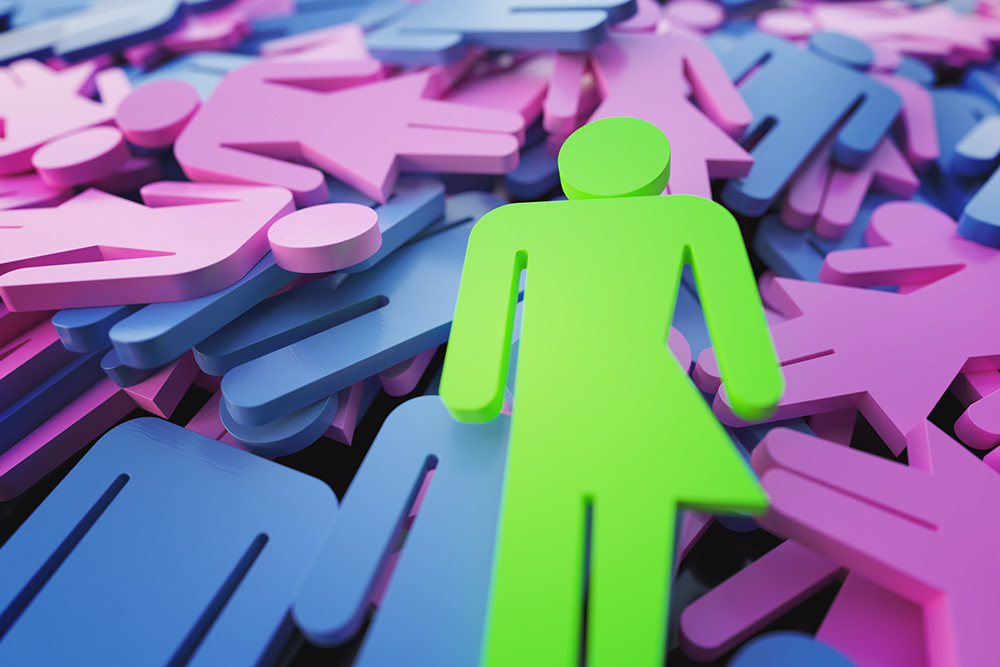
(Dreamstime/Vchalup)
Gross was granted a one-year leave of absence from the Dominicans to consider a sex/gender change and was forbidden under her vow of obedience to speak about her condition to her parents, her Dominican brothers or her friends. She was also unjustly denied any material or moral support. When her senior superiors heard of her congenital condition and the possibility of a sex/gender change, they treated her as a threat to the order and the church and recommended that she be dismissed from the priesthood.
A Vatican rescript then dismissed her from the priesthood and "reduced" her to the lay state. Gross then opted for a sex/gender reassignment and became Sally Gross and an activist for intersex issues.
Gross wrote that a "theologically sophisticated but fundamentalistic Christian of my acquaintance" said to her that, based on Genesis 1:27, "an intersexed person such as me does not satisfy the biblical criterion of humanity" and is also "congenitally unbaptizable."
Drawing on both her Jewish and Catholic education, Gross confesses to finding this comment "rather comical" and ignorant, given that the rabbinical tradition suggests that the original human was hermaphrodite, male and female, before Yahweh removed the female from Adam's side.
Gross concludes with legitimate theological ground: "I am a creature of God. ... I'm created, and intersex [and transgender] people are created, no less than anyone else, in the image and likeness of God."
Created by God equal to every other human creature, yes, but still cruelly lost sheep in and a threat to the Catholic Church and its unquestioned female-male sex binary.
Jesus' mission in the world was and is to search for the lost soul, sinner or non-sinner, until he finds it (Luke 19:10). The mission of the Catholic Church, which claims to be his body, cannot be different.
There are non-sinner transgender and intersex populations lost in the Catholic moral wilderness, and it is time, indeed past time, for the church to go in search of them, to find them, to affirm and respect them, and to cease bullying them and discriminating against them. In so doing, we suggest, transgender and intersex people will create, as Jesus said, "more joy in heaven" for the church will have "found my sheep which was lost" (Luke 15:6-7).
[Todd A. Salzman is the Amelia and Emil Graff Professor of Catholic Theology at Creighton University. Michael G. Lawler is the emeritus Amelia and Emil Graff Professor of Catholic Theology at Creighton University. They are the authors of Introduction to Theological Ethics: Foundations and Applications (Orbis Press, 2019) and the forthcoming Pope Francis and the Transformation of Catholic Health Care Ethics (Georgetown University Press, 2021).
